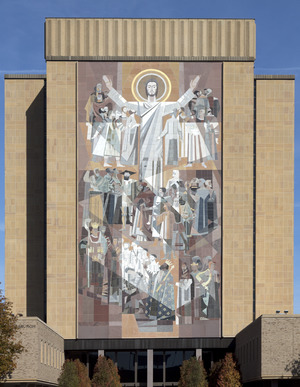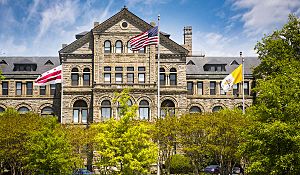History of Catholic education in the United States facts for kids
The History of Catholic Education in the United States tells the story of Catholic schools, colleges, and universities in America. It started in the early colonial days in places like Louisiana and Maryland. Over time, it grew into a large system of schools, especially in the 1800s, and continues to be important today.
Contents
- Colonial Era: Early Beginnings
- Parochial Era: Growth of Parish Schools
- Modern Era: Today's Catholic Education
- Notable Universities: A Closer Look
Colonial Era: Early Beginnings
In the early English colonies, there weren't many Catholics. The few who lived there, mostly in Maryland, had small local schools. These schools were often run by Jesuits, a Catholic religious order.
A very important group, the Oblate Sisters of Providence, were the first Black order of nuns. They were pioneers in teaching Black children. In 1828, they started St. Frances Academy in Baltimore. This was the first and oldest Black Catholic school in the United States.
Catholic schools were much more common in New Orleans. This city was controlled by Spain and France until 1803. Wealthy families sent their children to private Catholic schools. These schools were run by nuns from orders like the Ursulines. Ursuline Academy in New Orleans is the oldest continuously running school for girls in the U.S. It began in 1727. This school was special because it:
- Graduated the first female pharmacist.
- Had the first woman to write an important book.
- Was the first free school for girls.
- Offered the first classes for enslaved African-American girls, free women of color, and Native Americans.
Other orders, like the Sisters of the Holy Family, also taught enslaved children and other Black students. These students often couldn't get an education elsewhere. The Sisters taught them reading, writing, and job skills. Their school, St. Mary's Academy, started during the Civil War and is still open today.
Catholic universities also began during this time. They grew a lot alongside the elementary and high schools in the late 1800s and early 1900s. Even when some Catholic elementary schools faced challenges later on, the universities remained strong.
Parochial Era: Growth of Parish Schools
In the 1800s, most people in the U.S. were Protestant. When many Catholic immigrants arrived, especially from Ireland after the 1840s, some people worried. They thought Catholic children should go to public schools to become "more American."
However, Catholics worried that public schools, with Protestant teachers and students, might make their children lose their faith. So, they decided to build their own elementary schools, parish by parish. These were called "parochial schools." Nuns, who were paid very little, often taught in these schools. Protestants often opposed giving public money to these religious schools.
Blaine Amendments: No Public Money for Religious Schools
In 1875, President Ulysses S. Grant suggested a change to the U.S. Constitution. He wanted to make sure public schools were free and that no public money went to "sectarian" (religious) schools. He worried about the influence of the Catholic Church.
Senator James G. Blaine had proposed a similar idea in 1874. While this federal amendment didn't pass, it became a model for "Blaine Amendments" in 34 state constitutions. These state laws stopped public funds from going to religious schools. Many of these laws are still in effect today.
Colleges and Universities: Higher Education
Catholic universities grew as more students came from Catholic elementary and high schools. Many early Catholic universities were in the Washington D.C. area, like Georgetown University, Catholic University of America, and Trinity Washington University. University of Notre Dame was a notable exception outside this area.
Women's Colleges: New Opportunities
The first Catholic college for women in the U.S. was Notre Dame of Maryland University. It opened its four-year college program in 1895. By 1925, 42 more Catholic women's colleges had opened.
The ACCU: Working Together
The Association of Catholic Colleges and Universities (ACCU) was formed in 1899. This group helps Catholic colleges and universities work together.
Parochial School Growth and Structure
In 1904, Catholic educators created the Catholic Educational Association (now the National Catholic Educational Association). This group helped coordinate Catholic education across the country.
In the early parochial schools, the main goals were religious devotion and strict rules. Teachers, mostly nuns, often had little formal training beyond 8th grade themselves. Around 1911, Catholic colleges began offering summer classes to train the nuns in teaching methods. For a long time, Catholic schools often had fewer resources and less trained teachers compared to public schools.
Despite this, the number of Catholic schools and students grew quickly.
- In 1900, there were 3,500 Catholic elementary schools.
- By 1920, there were 6,551 elementary schools with 1.8 million students and 42,000 teachers (mostly nuns).
- Catholic high schools also boomed, from about 100 in 1900 to over 1,500 by 1920.
Supreme Court Upholds Parochial Schools
In 1922, voters in Oregon passed a law that would have forced all children to attend public schools. This law was mainly aimed at closing religious schools, including Catholic ones. Catholics were very upset. They organized to protect their right to send their children to Catholic schools. They wanted to prevent their children from losing their faith or culture.
In the case of Pierce v. Society of Sisters (1925), the U.S. Supreme Court ruled that Oregon's law was unconstitutional. This ruling was very important for Catholic schools. It affirmed that parents have the right to choose where their children go to school, including religious schools.
Irish and Polish Communities
By 1890, Irish immigrants, who were very influential in the U.S. Catholic Church, had built many parishes and schools in cities across the Northeast and Midwest. Irish and other Catholic groups saw these schools as a way to protect their religion, culture, and language.
Polish Americans also arrived in large numbers between 1890 and 1914. They often settled in industrial areas. They sent their children to parochial schools and encouraged young women to become nuns and teachers. In 1932, nearly 300,000 Polish American students attended over 600 Polish elementary schools in the U.S.
Peak and Decline of Parochial Schools
For many years, enrollment in Catholic schools steadily increased. By the mid-1960s, Catholic elementary schools had a record high of 4.5 million students, with about 1 million in high schools.
However, enrollment began to drop as Catholic families moved to the suburbs and their children attended public schools. A big change happened in the 1970s when many teaching nuns left their religious orders. This led to many schools closing. Others hired lay (non-religious) teachers, who were paid more, which meant higher tuition fees for students.
Most Catholic women's colleges, which numbered 116 by 1955, either became co-ed, merged with other schools, or closed after 1970.
Modern Era: Today's Catholic Education
Primary and Secondary Education
Catholic parochial schools still operate today. They have fewer students than in the past, and most teachers are now lay faculty, not nuns or priests. Many independent Catholic schools also exist. These schools often operate separately from the local diocese (church district).
Universities: Balancing Faith and Learning
Many Catholic universities today try to balance their Catholic identity with their role as academic institutions. Some groups, like the Cardinal Newman Society, work to promote universities that they see as truly upholding Catholic teachings. There is ongoing discussion about how Catholic universities can best combine their faith and academic goals.
Notable Universities: A Closer Look
University of Notre Dame

The University of Notre Dame, founded in northern Indiana in 1842, was modernized in the early 1900s. Under Rev. James Burns, it adopted a more flexible course system. This helped the school meet national academic standards.
The university became much more famous under Rev. Theodore Hesburgh, who was president for 35 years (1952–87). During his time, Notre Dame grew significantly:
- Its budget increased greatly.
- Its research funding went up.
- The number of students and faculty nearly doubled.
- The number of degrees awarded each year also doubled.
St. Mary's University, Texas
The Society of Mary (the Marianists) ran a boys' school in San Antonio, Texas, starting in 1852. In 1927, this school, St. Mary's College, began offering bachelor's degrees. It became a coeducational (for both boys and girls) school in 1963.
Today, St. Mary's University is a well-known liberal arts school. It has nearly 4,000 students from many different backgrounds and faiths. Its law school, founded in 1927, is the oldest Catholic law school in the Southwest.
The Catholic University of America
The idea for a national Catholic university in America came from the growing number of Catholics in the U.S. in the 1800s. It also showed a big vision for the Church's role in American life.
In 1882, Bishop John Lancaster Spalding got support from Pope Leo XIII for the university. A friend, Mary Gwendoline Caldwell, promised $300,000 to help start it. On March 7, 1889, the Pope officially approved the university. Its mission was to teach Catholicism and human knowledge together at a high level. The founders believed the university would strengthen the Catholic Church in the U.S. by creating new leaders and knowledge.
When the university first opened in 1888, it offered classes in philosophy, English, religious studies, and theology. Later, law classes were added. In 1904, an undergraduate program (for bachelor's degrees) was added. It quickly became known for its excellent education.


